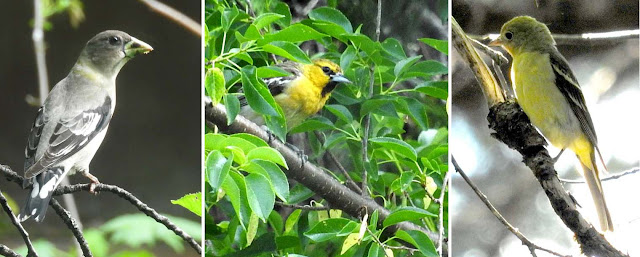Sierra Buttes - Tahoe National Forest
Temperatures got up into the high 90's this week! To get out of the heat, we drove up to the Lakes Basin and went hiking for a day. Due to its higher elevation, 5,000' to 8,000', it was a LOT cooler! There are still several feet of snow above 6,500'! The Lakes Basin is one of my favorite natural areas, and it's only about a 45 minute drive from our neighborhood. We hiked up to the snow, along one of the trails to Long Lake, and encountered these lovely wildflowers along the way!
We also saw this little Red-breasted Nuthatch! He (above left) was busy looking for something to eat in the crevices of the tree trunk. It looks like he found some kind of seed. Nuthatches move up, down, and sideways along tree trunks and branches in their search for food. They live in high elevation coniferous forests for most of the year. They will store nuts and insects for winter, in the crevices of tree bark. If winter conditions are too severe, they will migrate to lower elevations. These little birds don't live in my neighborhood, so it was a treat to watch him!
Steller's Jay - Cyanocitta stelleri
Back down in my neighborhood, it's still HOT!
This Steller's Jay isn't squawking in alarm, it's panting and spreading its feathers to get rid of excess heat! Birds can also keep from overheating by seeking shade, bathing in water, and becoming less active. It was amazing how few birds we saw, and how quiet it was in the hottest part of the day!
Spiny Lizard - Sceloperus sp.
A Lizard's body temperature fluctuates with the temperature of its environment. To keep from overheating, they move from sun to shade. They also avoid activity during the mid-day heat. I found this spiny lizard "basking" on the rocks in the morning sun!
Banana Slug - Ariolomax californicus
Banana slugs retreat into damp shade in hot weather. They are mainly active at night, as well as morning and evening. If it's severely hot, they coat themselves in a thick layer of slime and forest duff, roll up in a safe place, and estivate (become dormant)!
Last week I asked what Banana slugs eat, and what eats Banana Slugs. Well, they like to eat mushrooms, animal droppings, moss, lichen, and dead plant material. They are called detritivores, because they consume dead and decomposing organic matter.
It turns out that LOTS of animals eat slugs! Garter snakes, ducks, geese, salamanders, foxes, porcupines, crows, beetles, millipedes, shrews, and moles all eat slugs! Raccoons also eat slugs, but they roll them in duff before they eat them, to decrease the slime! To keep from being eaten, Banana Slugs will roll up into a ball and produce lots of slime!
American Robin - Turdus migratorius House Wren - Troglodytes aedon
Nesting News!
Unfortunately the Black-headed Grosbeak nestlings pictured in last week's blog didn't survive. They were probably eaten by predators. However, a Robin is incubating her eggs in the new nest I found (above left)! Yahoo! This new nest is only about 50 yards down the road, from the older failed Robin nest. The nesting materials are so similar that I wonder if it's the same Robin! What do you think?
Lots of birds in the neighborhood have just fledged. This morning I watched a fledgling Steller's Jay beg for food from an adult Steller's Jay, outside my studio window! On my morning walk, a group of House Wrens (above right) decided to come by and check me out! They are so tiny, but they have a loud rattling call! The adults are only 4.5" long including their tail! The young one I saw was even smaller! I was so delighted to watch an adult come and sit by this little fledgling! It was so cute when it begged for food!
Evening Grosbeak (female) Bullock's Oriole (male) Western Tanager (female)
Juveniles
I've also seen several juvenile birds in our garden. There have been male and female Orioles, Western Tanagers, and Evening Grosbeaks! They are so beautiful to watch!
So it seems, that despite predators, quite a few nestlings have survived!
Lots and lots of different species of insects are flying and crawling around everywhere! Here are a few that I photographed this week. The ladybugs are back. The crane flies are still around. The dragonfly larvae have changed into adults. There are tons of beetles eating and pollinating the plants! I'm afraid I'm not an insect specialist, and can't identify a lot of them! There's so much to learn!
Okay, so next week I'll let you know what's blooming locally!
Also, I haven't seen any bears or rattlesnakes!
Where are they?
Where do dragonfly larvae live?
Are there insects in the river?
What do birds do after their babies have fledged?
Check back next week for the answers to these questions and more!









No comments:
Post a Comment